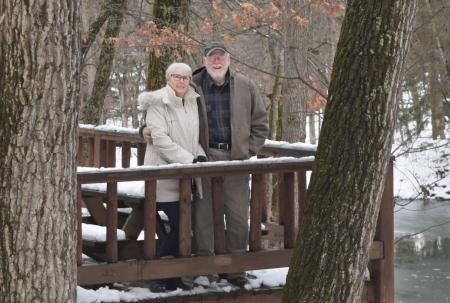
MONROE COUNTY, WI – An unusual three-way partnership is set to conserve important habitat in Monroe County. Two families, along with Mississippi Valley Conservancy, have been negotiating an agreement to protect the beauty and native species on 165 acres of forest and sand prairie adjacent to Fort McCoy.
Chris and Joyce Barlow have owned the land since 1988 and are in the process of selling it to Carrie and Brian Lord. Both families have a strong commitment to land conservation. With the affirmation of the Lords, the Barlows have signed a conservation easement with Mississippi Valley Conservancy that will protect the woodland, prairie and creeks when the property is sold to the Lords, and into the future.

“They have the same mindset,” said Joyce. “They’re glad to have the land in the Conservancy.”
Said Chris, “The easement makes the property much more appealing to them.”
While the land will stay in private hands, the conservation easement with the Conservancy will protect the land from habitat loss and development in perpetuity.
“Conserving the Barlow property is a win-win for land conservation and watershed protection, while also maintaining compatible land use with Fort McCoy,” said Chris Kirkpatrick, conservation specialist with the Conservancy
The property includes a mix of red and white oak forest and sand prairie, with cold water springs, seeps and ponds that form the headwaters of Tarr Creek, a tributary of the La Crosse River. The sand prairie continues onto Fort McCoy property, increasing the protected habitat for the federally endangered Karner blue butterfly.
Every conservation easement agreement with Mississippi Valley Conservancy is tailored to the wishes of the property owner and to the specific property. The restrictions of any easement pertain to all future owners and prohibit damaging activities including subdivision, development and mining.
“This is only the second time in the twenty-three-year history of the Conservancy that we’ve had the opportunity to negotiate the terms of the conservation easement with both the current owner and upcoming owner,” said Abbie Church, conservation director for the Conservancy. “In this case, Chris and Joyce have spent countless hours over the past twenty-five years, improving the habitat on their land. In Brian and Carrie, they found a land ethic in common and a shared vision for habitat management. The greatest benefit of this partnership is in the health of the land and wildlife.”
The Barlows and the Lords have been friends for years.
“Brian Lord pulled into the driveway one day and asked if they could hike the land,” said Joyce. “At times they’d be over a couple times a week.”
Said Chris Barlow, “We invited them in for cocoa and found they had the same outlook on conservation that we did.”
One day Brian and Chris were talking about the beauty of the place, and Chris asked: “Would you like to buy it?”
Chris and Joyce Barlow feel that they’re getting on in years, and the management and restoration of so much land can be burdensome.
Chris said, “Mother Nature takes things back in a hurry if you don’t keep at it.”
Even before the land changes hands from the Barlows to the Lords, the Lord family is getting involved.
“They helped with some of the conservation projects” said Chris. “It’s a family operation—and they’re half my age.”
Said Joyce, “Chris can leave here with the peace of mind knowing his work will continue, and they are excited to continue the work knowing Chris is still here to answer questions and teach them about the land.”
The Barlows have worked for many years to improve and restore the natural beauty of their land. They have rebuilt dams that protect several ponds, managed the forest and sand prairie to encourage native species and worked tirelessly to control invasive species.
To improve the sand prairie, and with help from the U.S. Fish and Wildlife Service and the Wisconsin DNR, the Barlows worked to eradicate invasive autumn olive and planted 61 prairie plant species native to Monroe County. The increased plant diversity will be an attraction for the Karner blue butterfly.
The forested slopes and ridges have been carefully managed by the Barlows as well. They have established a managed forest plan that includes sustainable timber harvest. Chris and Joyce were named Monroe County Tree Farmers of the Year in 2019.
“It took twenty-five years to get it where it is today,” said Chris.
Future owners Brian and Carrie Lord, and their two children Taylor and Trent, all share the same love for the land as do the Barlows.
“It’s the beauty, the changing terrain.” said Carrie; “Especially now in this somewhat crazy time, you can feel at peace and let the worries fall by the wayside.”
Said Brian, “For me it’s the diversity. I don’t know that you’ll find anything like it around.”
Of the Barlows Brian said, “They became mentors. We’ll forever be connected to them for their entrusting us to carry on their legacy.”
Thirteen-year-old daughter Taylor has her own story with these woods, ponds and prairie. As a young hunter, she took her first deer recently.
“I went out about 3:30 and watched a ten-pointer make his way in my direction,” said Taylor. “He stopped broadside, and I got a good shot.” With just a little help from her dad, she skinned and processed the deer herself.
Her 15-year-old brother, Trent, has taken the animal species list for the land and is identifying and photographing birds to produce a book. Songbirds that nest on the property include the rare and state threatened Cerulean warbler, and other forest birds including wood thrushes, yellow-billed cuckoos, and veery.
“I want my book to be for future generations,” said Trent. “I want people to go back and look and see what was there, and to see what is there today.”
The land abounds in stories, each personal, each unique.
Perhaps Chris Barlow said it best. “That’s one thing about the land—the stories that come with it. They aren’t planned; they just happen.”